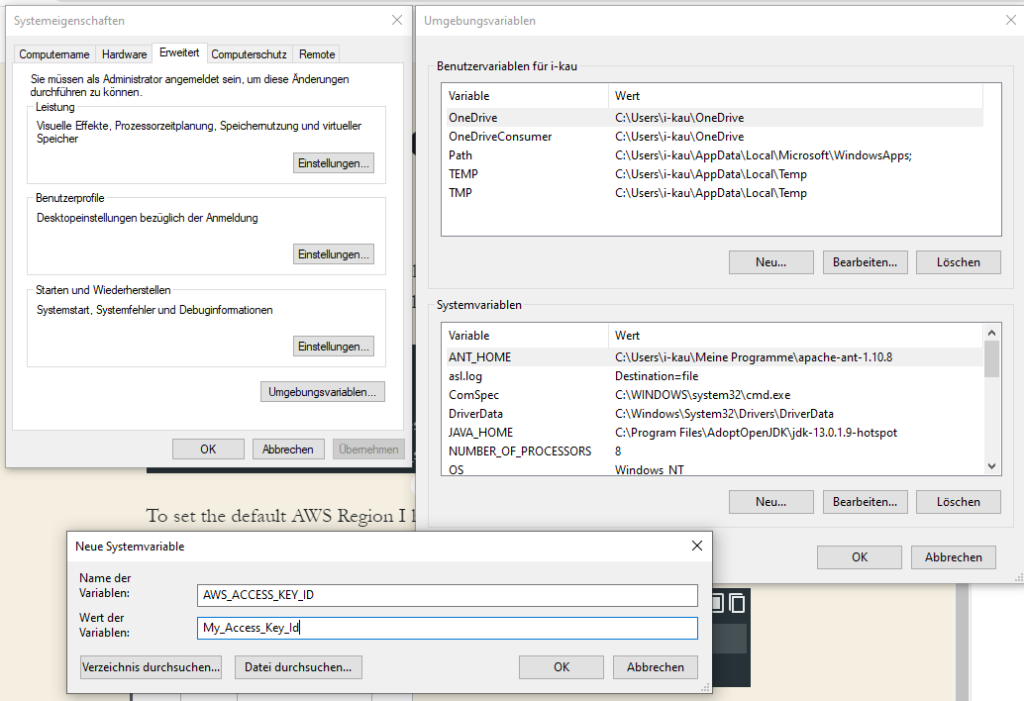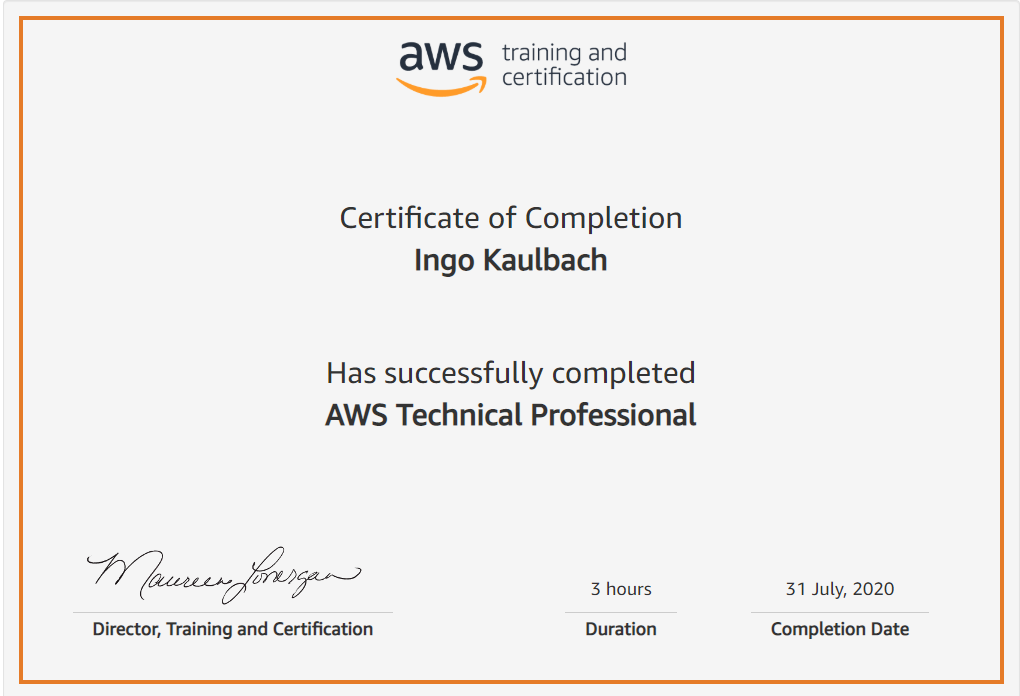Create an IAM user
I want to start with some practical experiences in AWS, so I go to https://aws.amazon.com, login with my Root user and open the Identity and Access Management (IAM ), where I create aa new IAM user, that I call "MyFirstProgrammaticAccessTestUser", because the user is of access type Programmatic access. For now, I do not add the user to any group and add only one tag (that I name tag-key) to the user.
AWS is warning, that this user has not permissons, but this is fine for now, I will add any permission as soon as the user needs one.
Finally I note down the user name, Access key ID and the secret access key.
Set up AWS credentials and region
I am working on a Windows machine, so I create a folder .aws in C:\Users\USERNAME. In this folder I create a file credentials:
[default] aws_access_key_id = your_access_key_id aws_secret_access_key = your_secret_access_key
To set the default AWS Region I have to create another file in .aws folder: config:
[default] region = eu-central-1
Additionally I have to set this information as environment variables.

I am really not sure, if this is the correct way to set this environment variables, but hey, this is only a test.
AWS SDK
I have to go to https://github.com/aws/aws-sdk-java-v2 to get the Clone with HTTPS URL.
Then open Eclipse and use the IMPORT dialog to import the project from GIT.
After checkout use the Configure -> Convert to Maven project dialog.
Then I tried Run as -> Maven install. But this results in a Build Failure:
[ERROR] Failed to execute goal com.github.spotbugs:spotbugs-maven-plugin:3.1.11:spotbugs (spotbugs) on project annotations: Execution spotbugs of goal com.github.spotbugs:spotbugs-maven-plugin:3.1.11:spotbugs failed: java.lang.IllegalArgumentException: Unsupported class file major version 57 -> [Help 1]
I found a clue, that I have to use Java 11 instead of my Java 13. So I downloaded a Java 11 JDK and added it to my Eclipse.
But unfortunately I have no clue, how to tell the embedded Eclipse Maven to use this Java 11 instead of Java 13. Great....NOT
Next try: Start a WSL Bash. Need to install Java and Maven first:
sudo apt install -y openjdk-11-jre maven cd /mnt/[...]/aws-sdk-java-v2 mvn clean install
Now it took 15 minutes to run until it ends wit an ERROR: There are test failures.
While I was waiting for the WSL-Maven to finish, I figured out, how to tell the Eclipse-Maven to run with the Java 11: I have to create a new Run Configuration where I explicite select the JRE:

The Eclipse-Maven also ends with an ERROR: There are test failures.
But for today I am fine with this result.
Create an AWS Maven Project
I create a new Maven project in Eclipse where I pull in the entire AWS SDK. This is not a good choice for a real world application, where you should only pull in components you need, but for a test project it's a good start.
This is my pom.xml:
<project xmlns="http://maven.apache.org/POM/4.0.0"
xmlns:xsi="http://www.w3.org/2001/XMLSchema-instance"
xsi:schemaLocation="http://maven.apache.org/POM/4.0.0 https://maven.apache.org/xsd/maven-4.0.0.xsd">
<modelVersion>4.0.0</modelVersion>
<groupId>test</groupId>
<artifactId>aws</artifactId>
<version>0.0.1-SNAPSHOT</version>
<packaging>war</packaging>
<properties>
<java.version>1.8</java.version>
<project.build.sourceEncoding>UTF-8</project.build.sourceEncoding>
<aws.java.sdk.version>2.14.7</aws.java.sdk.version>
</properties>
<dependencyManagement>
<dependencies>
<dependency>
<groupId>software.amazon.awssdk</groupId>
<artifactId>bom</artifactId>
<version>${aws.java.sdk.version}</version>
<type>pom</type>
<scope>import</scope>
</dependency>
</dependencies>
</dependencyManagement>
<dependencies>
<dependency>
<groupId>software.amazon.awssdk</groupId>
<artifactId>aws-sdk-java</artifactId>
<version>${aws.java.sdk.version}</version>
</dependency>
<dependency>
<groupId>org.apache.tomcat</groupId>
<artifactId>tomcat-catalina</artifactId>
<version>8.5.33</version>
<scope>provided</scope>
</dependency>
</dependencies>
<build>
<plugins>
<plugin>
<groupId>org.apache.maven.plugins</groupId>
<artifactId>maven-compiler-plugin</artifactId>
<version>3.8.0</version>
<configuration>
<source>${java.version}</source>
<target>${java.version}</target>
</configuration>
</plugin>
<plugin>
<groupId>org.apache.maven.plugins</groupId>
<artifactId>maven-war-plugin</artifactId>
<version>3.2.2</version>
<configuration>
<failOnMissingWebXml>false</failOnMissingWebXml>
<warName>ROOT</warName>
<wtpContextName>ROOT</wtpContextName>
</configuration>
</plugin>
</plugins>
</build>
</project>Add AWS SDK Logging
I wanted to add some logging so I put Log4J Libs dependencies to pom.xml and create a log4j2.xml file for configuration in src/main/resources folder.
log4j2.xml:
<?xml version="1.0" encoding="UTF-8"?>
<Configuration status="WARN">
<Appenders>
<Console name="ConsoleAppender" target="SYSTEM_OUT">
<PatternLayout pattern="%d{YYYY-MM-dd HH:mm:ss} [%t] %-5p %c:%L - %m%n" />
</Console>
</Appenders>
<Loggers>
<Root level="WARN">
<AppenderRef ref="ConsoleAppender"/>
</Root>
<Logger name="software.amazon.awssdk" level="WARN" />
<Logger name="software.amazon.awssdk.request" level="DEBUG" />
<Logger name="org.apache.http.wire" level="DEBUG" />
</Loggers>
</Configuration>pom.xml:
<properties>
<org.apache.logging.log4j.version>2.13.3</org.apache.logging.log4j.version>
</properties>
<dependencies>
<dependency>
<groupId>org.apache.logging.log4j</groupId>
<artifactId>log4j-core</artifactId>
<version>${org.apache.logging.log4j.version}</version>
</dependency>
<dependency>
<groupId>org.apache.logging.log4j</groupId>
<artifactId>log4j-api</artifactId>
<version>${org.apache.logging.log4j.version}</version>
</dependency>
<dependency>
<groupId>org.apache.logging.log4j</groupId>
<artifactId>log4j-slf4j-impl</artifactId>
<version>${org.apache.logging.log4j.version}</version>
</dependency>
</dependencies>First Test Application
A fist simple Test application to get some CloudeWatch metrics:
package aws;
import software.amazon.awssdk.regions.Region;
import software.amazon.awssdk.services.cloudwatch.CloudWatchClient;
import software.amazon.awssdk.services.cloudwatch.model.ListMetricsRequest;
import software.amazon.awssdk.services.cloudwatch.model.ListMetricsResponse;
import software.amazon.awssdk.services.cloudwatch.model.Metric;
public class TestMain {
public static void main(String[] args) {
String namespace = "<metric-namespace>";
Region region = Region.EU_CENTRAL_1;
CloudWatchClient cw = CloudWatchClient.builder()
.region(region)
.build();
listMets(cw, namespace) ;
}
public static void listMets( CloudWatchClient cw, String namespace) {
boolean done = false;
String nextToken = null;
while(!done) {
ListMetricsResponse response;
if (nextToken == null) {
ListMetricsRequest request = ListMetricsRequest.builder()
.namespace(namespace)
.build();
response = cw.listMetrics(request);
} else {
ListMetricsRequest request = ListMetricsRequest.builder()
.namespace(namespace)
.nextToken(nextToken)
.build();
response = cw.listMetrics(request);
}
for (Metric metric : response.metrics()) {
System.out.printf(
"Retrieved metric %s", metric.metricName());
System.out.println();
}
if(response.nextToken() == null) {
done = true;
} else {
nextToken = response.nextToken();
}
}
}
}
Result:
020-09-01 19:23:07 [main] DEBUG software.amazon.awssdk.request:84 - Sending Request: DefaultSdkHttpFullRequest(httpMethod=POST, protocol=https, host=monitoring.eu-central-1.amazonaws.com, encodedPath=, headers=[amz-sdk-invocation-id, Content-Length, Content-Type, User-Agent], queryParameters=[]) 2020-09-01 19:23:08 [main] DEBUG software.amazon.awssdk.request:84 - Received error response: software.amazon.awssdk.services.cloudwatch.model.CloudWatchException: User: arn:aws:iam::175335015168:user/MyFirstProgrammaticAccessTestUser is not authorized to perform: cloudwatch:ListMetrics (Service: CloudWatch, Status Code: 403, Request ID: 75f02535-28c7-49c8-930a-b8d8449c625a, Extended Request ID: null) Exception in thread "main" software.amazon.awssdk.services.cloudwatch.model.CloudWatchException: User: arn:aws:iam::175335015168:user/MyFirstProgrammaticAccessTestUser is not authorized to perform: cloudwatch:ListMetrics (Service: CloudWatch, Status Code: 403, Request ID: 75f02535-28c7-49c8-930a-b8d8449c625a, Extended Request ID: null) at software.amazon.awssdk.core.internal.http.CombinedResponseHandler.handleErrorResponse(CombinedResponseHandler.java:123) at software.amazon.awssdk.core.internal.http.CombinedResponseHandler.handleResponse(CombinedResponseHandler.java:79) at software.amazon.awssdk.core.internal.http.CombinedResponseHandler.handle(CombinedResponseHandler.java:59) at software.amazon.awssdk.core.internal.http.CombinedResponseHandler.handle(CombinedResponseHandler.java:40) at software.amazon.awssdk.core.internal.http.pipeline.stages.HandleResponseStage.execute(HandleResponseStage.java:40) at software.amazon.awssdk.core.internal.http.pipeline.stages.HandleResponseStage.execute(HandleResponseStage.java:30) at software.amazon.awssdk.core.internal.http.pipeline.RequestPipelineBuilder$ComposingRequestPipelineStage.execute(RequestPipelineBuilder.java:206) at software.amazon.awssdk.core.internal.http.pipeline.stages.ApiCallAttemptTimeoutTrackingStage.execute(ApiCallAttemptTimeoutTrackingStage.java:73) at software.amazon.awssdk.core.internal.http.pipeline.stages.ApiCallAttemptTimeoutTrackingStage.execute(ApiCallAttemptTimeoutTrackingStage.java:42) at software.amazon.awssdk.core.internal.http.pipeline.stages.TimeoutExceptionHandlingStage.execute(TimeoutExceptionHandlingStage.java:77) at software.amazon.awssdk.core.internal.http.pipeline.stages.TimeoutExceptionHandlingStage.execute(TimeoutExceptionHandlingStage.java:39) at software.amazon.awssdk.core.internal.http.pipeline.stages.ApiCallAttemptMetricCollectionStage.execute(ApiCallAttemptMetricCollectionStage.java:50) at software.amazon.awssdk.core.internal.http.pipeline.stages.ApiCallAttemptMetricCollectionStage.execute(ApiCallAttemptMetricCollectionStage.java:36) at software.amazon.awssdk.core.internal.http.pipeline.stages.RetryableStage.execute(RetryableStage.java:64) at software.amazon.awssdk.core.internal.http.pipeline.stages.RetryableStage.execute(RetryableStage.java:34) at software.amazon.awssdk.core.internal.http.pipeline.RequestPipelineBuilder$ComposingRequestPipelineStage.execute(RequestPipelineBuilder.java:206) at software.amazon.awssdk.core.internal.http.StreamManagingStage.execute(StreamManagingStage.java:56) at software.amazon.awssdk.core.internal.http.StreamManagingStage.execute(StreamManagingStage.java:36) at software.amazon.awssdk.core.internal.http.pipeline.stages.ApiCallTimeoutTrackingStage.executeWithTimer(ApiCallTimeoutTrackingStage.java:80) at software.amazon.awssdk.core.internal.http.pipeline.stages.ApiCallTimeoutTrackingStage.execute(ApiCallTimeoutTrackingStage.java:60) at software.amazon.awssdk.core.internal.http.pipeline.stages.ApiCallTimeoutTrackingStage.execute(ApiCallTimeoutTrackingStage.java:42) at software.amazon.awssdk.core.internal.http.pipeline.stages.ApiCallMetricCollectionStage.execute(ApiCallMetricCollectionStage.java:48) at software.amazon.awssdk.core.internal.http.pipeline.stages.ApiCallMetricCollectionStage.execute(ApiCallMetricCollectionStage.java:31) at software.amazon.awssdk.core.internal.http.pipeline.RequestPipelineBuilder$ComposingRequestPipelineStage.execute(RequestPipelineBuilder.java:206) at software.amazon.awssdk.core.internal.http.pipeline.RequestPipelineBuilder$ComposingRequestPipelineStage.execute(RequestPipelineBuilder.java:206) at software.amazon.awssdk.core.internal.http.pipeline.stages.ExecutionFailureExceptionReportingStage.execute(ExecutionFailureExceptionReportingStage.java:37) at software.amazon.awssdk.core.internal.http.pipeline.stages.ExecutionFailureExceptionReportingStage.execute(ExecutionFailureExceptionReportingStage.java:26) at software.amazon.awssdk.core.internal.http.AmazonSyncHttpClient$RequestExecutionBuilderImpl.execute(AmazonSyncHttpClient.java:193) at software.amazon.awssdk.core.internal.handler.BaseSyncClientHandler.invoke(BaseSyncClientHandler.java:128) at software.amazon.awssdk.core.internal.handler.BaseSyncClientHandler.doExecute(BaseSyncClientHandler.java:154) at software.amazon.awssdk.core.internal.handler.BaseSyncClientHandler.lambda$execute$1(BaseSyncClientHandler.java:107) at software.amazon.awssdk.core.internal.handler.BaseSyncClientHandler.measureApiCallSuccess(BaseSyncClientHandler.java:162) at software.amazon.awssdk.core.internal.handler.BaseSyncClientHandler.execute(BaseSyncClientHandler.java:91) at software.amazon.awssdk.core.client.handler.SdkSyncClientHandler.execute(SdkSyncClientHandler.java:45) at software.amazon.awssdk.awscore.client.handler.AwsSyncClientHandler.execute(AwsSyncClientHandler.java:55) at software.amazon.awssdk.services.cloudwatch.DefaultCloudWatchClient.listMetrics(DefaultCloudWatchClient.java:1877) at aws.TestMain.listMets(TestMain.java:33) at aws.TestMain.main(TestMain.java:17)
So the Error is:
user/MyFirstProgrammaticAccessTestUser is not authorized to perform: cloudwatch:ListMetrics
I try to solve this by going back to the IAM console and add the user to a new created group with attached policy "CloudWatchFullAccess".
Result:
2020-09-01 19:38:27 [main] DEBUG software.amazon.awssdk.request:84 - Sending Request: DefaultSdkHttpFullRequest(httpMethod=POST, protocol=https, host=monitoring.eu-central-1.amazonaws.com, encodedPath=, headers=[amz-sdk-invocation-id, Content-Length, Content-Type, User-Agent], queryParameters=[]) 2020-09-01 19:38:28 [main] DEBUG software.amazon.awssdk.request:84 - Received successful response: 200
So this worked, this was quite intuitive 🙂
The result is empty, I guess because of the metric-namespace that I initaly set with placeholder name. I looked into my CloudWatch Dashboard, but could not find any metric with data. I guess, I have to create a metric and find a way to create data for the metric. TBC




